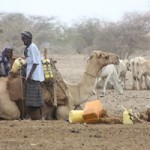
Kenyans hosting the new arrivals, donors, human rights organizations and aid agencies have been leaning on the Kenyan authorities to assist the refugees with food and medical help, and to resume screening them for security threats.
The drought-triggered crisis that has affected both countries has left the local host community in Liboi feeling less hospitable, as they are obliged to share limited food and water resources with the new arrivals.
Another concern is the lack of screening of refugees, leaving locals worried about security threats from Al-Shabab insurgents, as well as disease. Outbreaks of cholera, diarrhoea and measles have been reported in Somalia’s capital.
Until Kenya officially closed its border with Somalia in January 2007 as a security measure, Liboi, a dusty town about 18km from the frontier and 80km from Dadaab, was the major transit and screening centre for refugees. At least 200,000 Somalis passed through the town during the early 1990s. Transport to Daadab saved refugees a difficult trek through the desert.
The suspension of screening proved unpopular with NGOs and UN agencies as it effectively trapped refugees in the nearby town of Dobley.
But refugees have continued to stream in, vulnerable to abuse either by bandits or Kenyan law enforcement officials, according to Amnesty International and Human Rights Watch (HRW).
Neela Ghosal, a researcher with HRW, said Somalis cited police extortion, violence, arbitrary arrest and detention, and unlawful deportation to Somalia during their trek to Dadaab.
Last year, Dadaab received an average of 6,000 to 8,000 Somalis every month, according to the UN Refugee Agency (UNHCR). In 2011, the monthly average increased to 10,000, with more than 55,000 new arrivals since the beginning of the year, dropping to 700-800 daily in the past few weeks, according to some agencies.
Benedicte Goderiaux, an Africa researcher with Amnesty, said the Kenyan government had failed to respond to the protection needs of the refugees.
Host community
The Kenyan government has been divided over the need to provide protection for the refugees or deter the influx that could also include Al-Shabab militants by keeping the borders officially closed.
Since famine was declared in Somalia in July, refugee numbers have soared, leading to increased concern among Kenyans living near the border.
“It is not that we don’t want to share our food – how can we not help women and children sitting under the tree in the open and hungry?” asked Dekow Mohammed, chair of Liboi’s water and sanitation committee, when IRIN visited the town.
“We share the same faith, we are all [ethnically] Somalis but we are also affected by the drought – we pay for our water which we share with them,” he said.
“But these people have been sitting here for two days now – what if they are carrying some weapons in their bags? What if they have a disease? We have to think about our people as well,” added Mohammed.
When IRIN visited Liboi on 14 August, 262 Somalis, mostly women and children, sat under trees – the largest number to arrive in recent weeks.
Liboi is only of the several border towns; the others are Mandera and El Wak. Despite the border closure, local authorities have allowed local trade and movement in most instances at their own discretion.
Security concerns
Badu Katelo, Kenya’s acting commissioner for refugees, maintained that the borders had never been closed for refugees.
Katelo told IRIN the government was poised to re-open the reception centre and resume screening Somali refugees in Liboi. He said the situation had improved along the border, where the Somali Transitional Federal Government was in control.
The centre and screening facilities could be operational again within a few weeks. “The modalities are still being worked out but we will have a small registration process [at the new centre] – where we will do short profiles of people.” The screening will include a medical examination and a security check. The centre will be run by UNHCR, he said.
Emmanuel Nyabera, UNHCR spokesman, said the agency was in negotiations with the government and the “centre and screening facilities will open soon”. He said they hoped to provide medical assistance and some food to the new arrivals.
After the official screening the refugees can now be transported to Dadaab. A small accommodation area is also in the works, said Katelo, for refugees who cannot be moved within 24 hours.
But some aid workers regard the announcement with some apprehension, saying some government officials feel the re-opening would encourage more people to come to Kenya.
“We are not going to open transit centres in other border towns – we will only limit it to Liboi,” maintained Katelo.
IRIN News
jk/am/mw
Theme (s): East African Food Crisis, Environment, Food Security, Health & Nutrition, Human Rights, Migration, Natural Disasters, Refugees/IDPs, Water & Sanitation,
[This report does not necessarily reflect the views of the United Nations]
